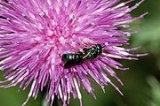
Ceratina
Encyclopedia
The cosmopolitan bee
genus Ceratina, often referred to as small carpenter bees, is the sole lineage of the tribe Ceratinini, and closely related to the more familiar carpenter bee
s. They make nests in dead wood, stems, or pith, and while many are solitary, a number are subsocial
, with mothers caring for their larvae, and in a few cases where multiple females are found in a single nest, daughters or sisters may form very small, weakly eusocial colonies (where one bee forages and the other remains in the nest and lays eggs).
Ceratina are commonly dark, shining, even metallic bees, with fairly sparse body hairs and a weak scopa
on the hind tibia. Most species have some yellow markings, most often restricted to the face, but often elsewhere on the body. They are very commonly mistaken for "sweat bees" (family Halictidae
), due to their small size, metallic coloration, and some similarity in wing venation; they can be easily separated from halictids by the mouthparts (with a long glossa) and the hindwings (with a tiny jugal lobe).
A few species are exceptional among bees in that they are parthenogenetic, reproducing without males.
Bee
Bees are flying insects closely related to wasps and ants, and are known for their role in pollination and for producing honey and beeswax. Bees are a monophyletic lineage within the superfamily Apoidea, presently classified by the unranked taxon name Anthophila...
genus Ceratina, often referred to as small carpenter bees, is the sole lineage of the tribe Ceratinini, and closely related to the more familiar carpenter bee
Carpenter bee
Carpenter bees are large, hairy bees distributed worldwide. There are some 500 species of carpenter bee in 31 subgenera...
s. They make nests in dead wood, stems, or pith, and while many are solitary, a number are subsocial
Subsociality
Subsociality is a term used simply to refer to when an organism exhibits any form of parental behaviour. It is the most common and widespread form of sociality. In many species the mother, father or both parents either care for the young directly, or simply build a nest....
, with mothers caring for their larvae, and in a few cases where multiple females are found in a single nest, daughters or sisters may form very small, weakly eusocial colonies (where one bee forages and the other remains in the nest and lays eggs).
Ceratina are commonly dark, shining, even metallic bees, with fairly sparse body hairs and a weak scopa
Scopa (biology)
The term scopa is used to refer to any of a number of different modifications on the body of a non-parasitic bee that form a pollen-carrying apparatus. In most bees, the scopa is simply a particularly dense mass of elongated, often branched, hairs on the hind leg...
on the hind tibia. Most species have some yellow markings, most often restricted to the face, but often elsewhere on the body. They are very commonly mistaken for "sweat bees" (family Halictidae
Halictidae
Halictidae is a cosmopolitan family of the order Hymenoptera consisting of small to midsize bees which are usually dark-colored and often metallic in appearance...
), due to their small size, metallic coloration, and some similarity in wing venation; they can be easily separated from halictids by the mouthparts (with a long glossa) and the hindwings (with a tiny jugal lobe).
A few species are exceptional among bees in that they are parthenogenetic, reproducing without males.
External links
- Ceratina Identification Guide
- List of Species
- Worldwide Species Map
- Small carpenter bee Ceratina sp. diagnostic photos and descriptions
- carpenter bees, Ceratina spp. on the UFUniversity of FloridaThe University of Florida is an American public land-grant, sea-grant, and space-grant research university located on a campus in Gainesville, Florida. The university traces its historical origins to 1853, and has operated continuously on its present Gainesville campus since September 1906...
/ IFASInstitute of Food and Agricultural SciencesThe University of Florida’s Institute of Food and Agricultural Sciences is a federal-state-county partnership dedicated to developing knowledge in agriculture, human and natural resources, and the life sciences, and enhancing and sustaining the quality of human life by making that information...
Featured Creatures Web site

